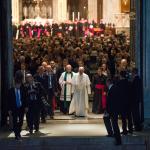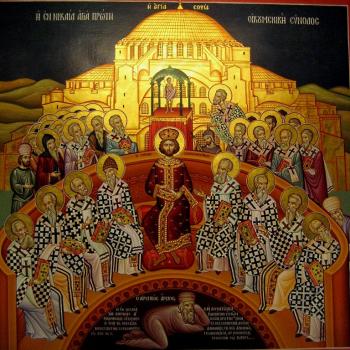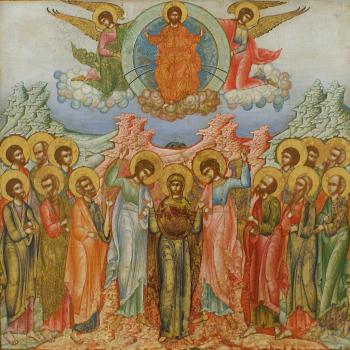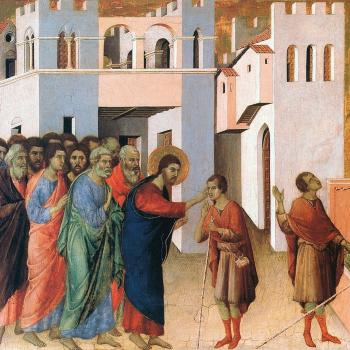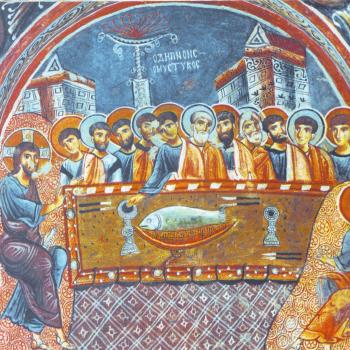
Creation, and all that is in it, are united as one. All creation shares with each other a created nature, and with that common nature, their destinies are intertwined. Together they form an interdependent unity. They are bonded together in a pluralistic unity which recognizes distinctions within its oneness (that is, theirs is a compounded unity, a unity composed of parts). The parts which form the whole can be separated from each other. If they are, instead of having a bond which connects them together, they have a nihilistic void formed between them, a void which not only seeks to keep them apart, but to break them up into further, smaller, parts. Then, when those parts are small enough, the void seeks to consume them. In the end, all that would be left is the void itself if it is not halted from its activity. The reason why this does not happen is because the void has been stopped by the creator. The one who created all things, recreates all things, healing the damage done by the void. Even the bonds which had been destroyed are recreated, and instead of having a nihilistic end, creation will end up being united with the creator of all things, lifted up and made greater than what it was in the beginning.
The creator gave creation the freedom it needs to establish itself in time (and in doing so, break itself apart and establish the void). But because the creator loves creation, the creator does not want creation to annihilate itself. Thus, the creator entered into creation, taking a part of its activity. What the creator does within creation becomes a part of the activity of creation itself. The creator restores creation from within, using the freedom given to creation to work for the restoration of creation to its integral, original unity. This is the first step for the creator’s goal for creation, to lift it up and allow it to partake of the divine life. In this way, the one in whom all things were made, the Logos, is now also the “first-born” of all creation. The Logos took on a created nature, assuming it in such a way as to truly be creature while still being, at the same time, the creator. This is what we have with the incarnation in the person of Jesus: the incarnate one is the creator of all things, and yet that one is also a part of creation, indeed, through the incarnation, has become human:
He is the image of the invisible God, the first-born of all creation; for in him all things were created, in heaven and on earth, visible and invisible, whether thrones or dominions or principalities or authorities — all things were created through him and for him. He is before all things, and in him all things hold together. He is the head of the body, the church; he is the beginning, the first-born from the dead, that in everything he might be pre-eminent (Col. 1:15-18 RSV).
We should not read this as being a discussion of history, that is, as saying that the Logos assumed human nature and became a man before anything else happened in history; rather, the incarnation is the “first born” of all creation in the sense that the incarnation is the purpose of creation, the first thought (archon) behind creation itself. That is, all things in creation were made in light of the incarnation. For God, there is one eternal action, and so for God, things are known and established in ontological and logical priority, not in temporal ones. Thus, the incarnation has an ontological, not a temporal, priority, and in that priority, it is the “first born of all creation.” All things were made in and through the Logos, but also all things were made in the light of the incarnation. In this fashion, the Logos holds all things together in two ways, one through the divine nature, and one through the incarnation and its created nature.
The incarnation takes place in history, at its own proper time and place, one which gives the incarnation a pre-history, that is a history before the incarnation, and a post-history, that is a history which takes place after the incarnation (allowing some to say, symbolically, the incarnation takes place at the center of all history). The ontological preeminence must not be confused with a temporal one, but, on the other hand, this does not mean the incarnation does not have influence throughout all history. Its influences is established throughout time because of its ontological priority. It is this preeminence, moreover, which allows the Logos to enter into creation and overcome the destruction wrought to creation by the actions the rest of creation, that is, the incarnation is able to overcome the void which creation had established through its poor decisions. The void was established, and now is reinforced by all the sin that is done in time. Sin breaks down and destroys things, dividing them into more and more parts, while the Logos, in becoming a part of creation, is able to work within creation to heal the damage done by sin and reestablish the links which the void had replaced. In this way, all things are joined brought back together as one in the Logos, and through that unity, will find themselves brought into a new creation, a superior one, one which will know no sin, no void, no death.
The healing ministry of Jesus was just one of the ways Jesus worked in the world to restore what the void had destroyed. Jesus continues that ministry with us, coming to us in our lives so that we can find ourselves spiritually healed. Jesus gives us the seeds of grace which we need; now, we must plant them in our lives so that they can bloom forth in the spaces of the void, overtaking the void so that there will be no place left for its destructive influences. The restoration which we receive by Christ takes into consideration our own histories; it does not rewrite them, overriding them as if they did not happen, but rather, it finds a place within them to draw us away from all the pain and sorrow we have experienced and into the new life of the spirit, the new life of grace. That is, we do not lose our histories. They do not vanish and become rewritten. What changes is their outcome. Jesus is able to take them upon himself and work with them so that they do not have to lead us to the void. Jesus, instead, holds us together, overcoming the void, giving us restorative grace, so that once we have been healed from the harm done to us by the void, we can be brought with him to the new, spiritualized state of the resurrection. For in the resurrection not only will all things be as they were when they were created, they will become as they were meant to be, that is, united with the Logos, and through the Logos, with God. In the Logos, in our unity with the Logos, our experience will be one of eternal glorification instead of annihilation. For the incarnation was the purpose of creation; God created creation so that God can join it with the divine life, giving creation the chance to enjoy the glory of the divine nature for itself:
Let us sing to the Lord a new song, for He has done marvelous things, and will do even more wonderful things by the presence of Christ, through which all things come from annihilation to re-creation, through which the old things appear as new and take on a vigorous new life by being elevated to God.[1]
[1] St Sophronios of Jerusalem, “Homily 4: Homily on the Presentation of our Lord and Savior Jesus Christ” in Homilies. Trans. John M. Duffy (Cambridge: Harvard University Press, 2020), 129.
Stay in touch! Like A Little Bit of Nothing on Facebook.
If you liked what you read, please consider sharing it with your friends and family!


